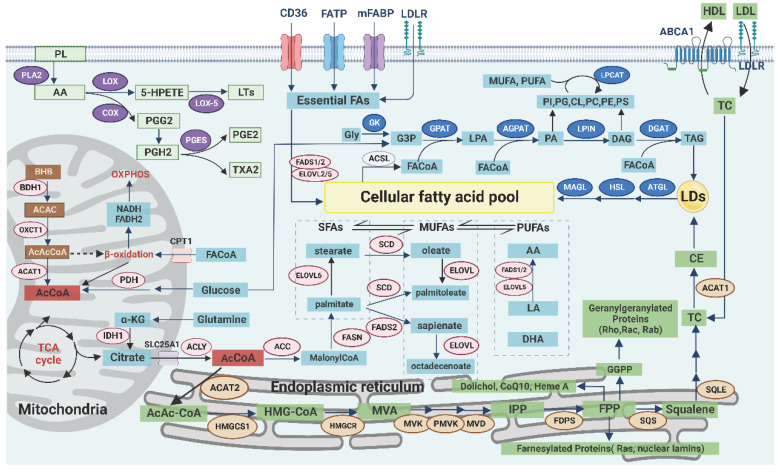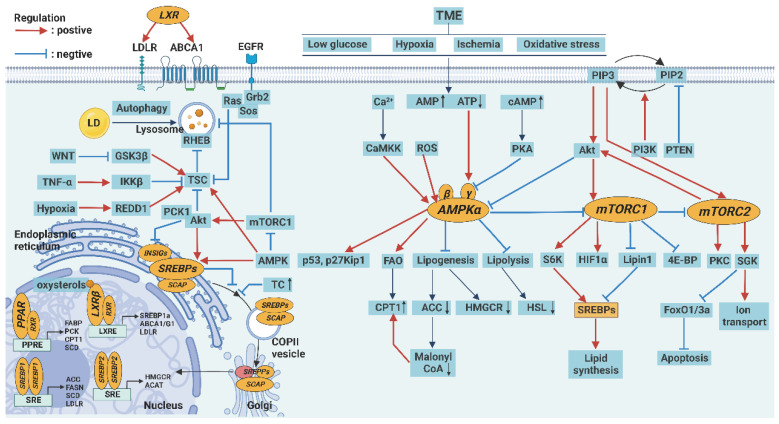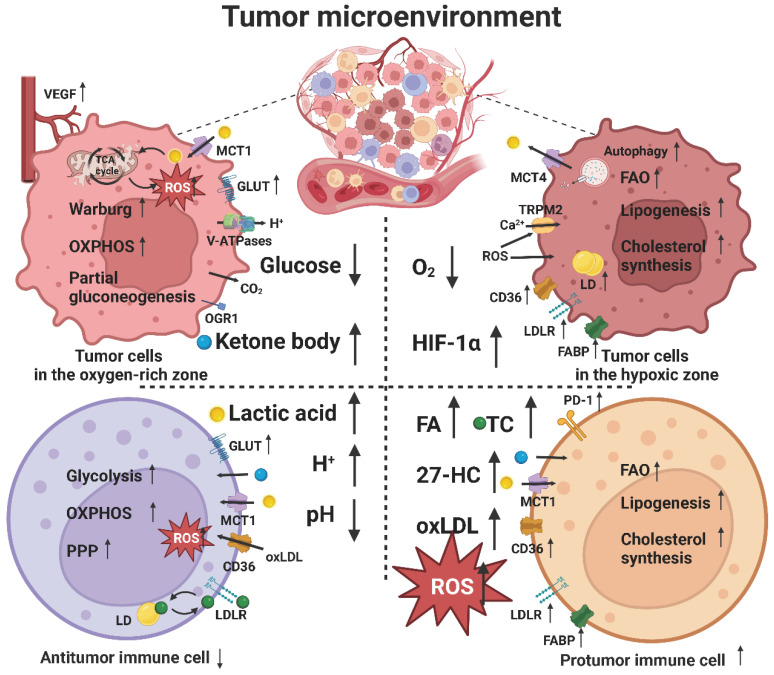Abstract: Since the microenvironment of cancer cells is different from normal cells, they have to be rapidly suitable for hypoxia and malnutrition. The adaptive mechanism is called metabolic reprogramming and has been identified as one of the typical cancer features. During hypoxia and malnutrition, cancer cells use glycolysis to rapidly provide ATP and support their growth. They also provide biomacromolecules required by cell replication via pentose phosphate pathway(PPP) and serine metabolic pathway. Metabolic reprogramming is very important for malignant transformation of cancer cells, tumor invasion and metastasis. Its role in regulating immune microenvironment and lipid metabolism in cancer immunotherapy is also very important.
Keywords: Lipid Metabolism, Tumor Microenvironment, Metabolic Reprogramming, Metabolism Pathway, Cancer Immunotherapy
1. Specific Roles of Lipid in Cancer Cells
Energy Storage: cancer cells satisfy the high energy demand via lipid storage and utilization.
Membrane structure support: lipid is the key component of cell membrane, supporting the structure and function of cancer cells.
Signal transduction: lipid is involved in signaling pathway of cells, regulating the growth and survival of cancer cells.
Promote proliferation and invasion: some lipids(e.g. phospholipids and sphingolipids) can promote the proliferation and invasion of cancer cells.
Regulation of Immune Reaction: lipid can affect the immune reaction in tumor microenvironment, assisting in cancer cells to avoid the immunosurveillance.
Thus, lipid plays an important role in cancer development and treatment.
2. Abnormal Lipid Metabolism in Cancer
Lipid metabolism (especially anabolism) is highly active in cancer cells, promoting their survival and development in tumor microenvironment via involving in lipid intake, synthesis, storage, decomposition, and high expression of key enzymes.
In the membrane, phospholipid-released fatty acid is involved in synthetic pathway of prostaglandin, affecting inflammation and redox balance. Exogenous lipids (especially fatty acids) can form monounsaturated fatty acid(MUFA) via transport of various receptors into cell membrane. In mitochondrion, acetyl-CoA(AcCoA) can be generated from glucose, glutamine, acetic acid or ketone, and then enter cytoplasm to continue fatty acid synthesis. In endoplasmic reticulum, AcCoA is involved in cholesterol synthesis. Intermediate products are related to lipid modification and redox balance. In cytoplasm, de novo synthesis product of fatty acid is saturated fatty acid(SFA). These SFAs further extend and desaturate to form MUFA. Redundant lipids are stored in lipid droplet in the form of triglyceride and cholesteryl ester. Fatty acid is necessarily released via Lands recycling as substrate for lipid remodeling.

3. Lipid Metabolism Pathway
The expression of key enzyme in lipid metabolism can be regulated by various signaling pathway, including AMPK, mTOR, PPAR, SREBP and LXR. In endoplasmic reticulum, SREBP exists as inactive precursor and transmembrane protein, and binds with SREBP cleavage-activating protein(SCAP). When the cholesterol level in the cell decreases, SREBP is transported to golgi apparatus. After two-step protein hydrolysis, N-terminal half protein is released. Then, mature SREBP is transported to nucleus. In nucleus, transcription regulatory factors controlling synthesis and transportation of fatty acid and cholesterol include SREBP, LXR and PPAR, which respectively binds with SREs, LXRE and PPREs in the promoter region of the target gene as homodimer or heterodimer. In tumor microenvironment, energy stress, increased level of Ca2+ and oxidative stress increases the ratio of AMP/ATP or ADP/ATP. The activation of AMPK inhibits mTOR, promoting autophagy accordingly.

4. Lipid Metabolic Reprogramming in Tumor Microenvironment
Tumor microenvironment(TME) plays an important role in tumor immunotherapy. Cancer cells can change cell metabolism in tumor microenvironment and disrupt the metabolism of cancer cells, especially tumor associated immune cells. Cancer cells have the high demand on nutrient substance. The deficiency of nutrient substance will cause metabolic stress in tumor microenvironment, including hypoxia-induced anoxic environment and hypoglycemia-induced energy competition. Besides, the metabolites of cancer cells or other cells accumulate in the microenvironment, forming lactic acid accumulation-induced low pH environment, and lipid and ROS accumulation-induced lipid peroxidation environment. Thus, cancer and immune cells will cause metabolic reprogramming to avoid these limitations, affecting tumor immune reaction.

5. Clinical Application of Lipid Metabolic Reprogramming
Lipid metabolic reprogramming is a new field, interfering with diseases or promoting health via regulating lipid metabolism pathway. Wide clinical potentials are found in metabolic syndrome, cardiovascular disease, cancer, neurodegenerative diseases, inflammation, liver disease etc. The change of lipid metabolism can improve insulin resistance, decrease cholesterol and triglyceride level, interfere with lipid synthesis, regulate inflammatory reaction and slow down the progress of neurodegenerative diseases. With the further research, lipid metabolic reprogramming is expected to offer more individual therapies.
